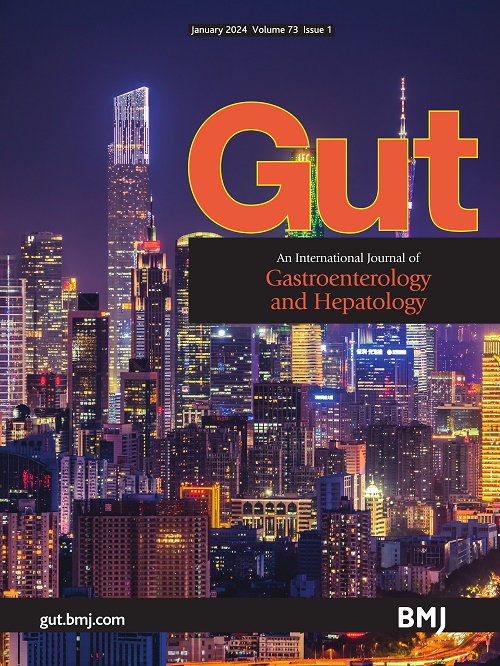Alleviated T cell exhaustion and SLC1A3-mediated stroma-remodelling dictate chemoimmunotherapy efficacy in oesophageal squamous cell carcinoma
IF 25.8
1区 医学
Q1 GASTROENTEROLOGY & HEPATOLOGY
引用次数: 0
Abstract
Background Combining chemotherapy with anti-programmed cell death protein-1 (PD-1) improves clinical outcomes in oesophageal squamous cell carcinoma (ESCC), yet the underlying synergistic mechanism remains obscured. Moreover, 30–50% of patients still derive no therapeutic benefit from the combination strategy, highlighting the need to decipher and overcome resistance. Objective We sought to investigate the mechanisms by which chemotherapy augments the responses to immune checkpoint blockade and elucidate the factors contributing to persistent resistance in non-responding patients. Design We designed a systematic investigation involving longitudinal sampling of ESCC tissues both from patients treated with chemotherapy plus anti-PD-1 and anti-PD-1 monotherapy. The tumour microenvironment (TME) was then comprehensively characterised using single-cell transcriptomics, T cell receptor repertoire analysis, multiplex immunohistochemistry and murine models. Results We demonstrated that combination therapy exerted superior antitumour efficacy by mitigating immune checkpoint engagements (TIGIT-NECTIN2 and NECTIN1-CD96) between epithelial-stress tumour cells and CD8+ T cells, thereby preventing T cells from exhaustion and boosting vitality. In non-responders, we identified a subset of tumour cells with high SLC1A3 expression, which localised at the tumour boundary and interacted with COL1A1+ myofibroblastic cancer-associated fibroblasts, inducing an extracellular matrix-enriched TME that hindered the infiltration of CD8+ T cells. Inhibiting SLC1A3 significantly enhanced the efficacy of chemotherapy plus anti-PD-1, underscoring its potential as a therapeutic target. Conclusion This study elucidates the synergistic mechanisms and identifies key resistance pathways underlying chemo-immunotherapy combinations in patients with ESCC, providing a scientific basis for refining future combination therapeutic regimens. Data are available in a public, open access repository. Data are available upon reasonable request. The curated high-quality scRNA-seq data, scTCR-seq of ESCC patient samples and mouse scRNA-seq data were deposited at in the Genome Sequence Archive at the National Genomics Data Center with accession numbers: PRJCA037418. The raw sequencing data of validated ESCC scRNA-seq cohort and bulk RNA-seq of Li et al 2023 ESCC cohort could be obtained in the Genome Sequence Archive at the National Genomics Data Center with accession numbers: PRJCA012636[20][1]. Any additional information required to reanalyse the data reported in this paper is available from the lead contact upon reasonable request. [1]: #ref-20缓解T细胞衰竭和slc1a3介导的基质重塑决定了化疗免疫治疗在食管鳞状细胞癌中的疗效
化疗联合抗程序性细胞死亡蛋白-1 (PD-1)可改善食管鳞状细胞癌(ESCC)的临床预后,但其潜在的协同机制尚不清楚。此外,30-50%的患者仍然没有从联合策略中获得治疗益处,这突出了破译和克服耐药性的必要性。目的探讨化疗增强免疫检查点阻断应答的机制,并阐明导致无应答患者持续耐药的因素。我们设计了一项系统调查,包括对接受化疗加抗pd -1治疗和抗pd -1单药治疗的ESCC患者的组织进行纵向抽样。然后利用单细胞转录组学、T细胞受体库分析、多重免疫组织化学和小鼠模型全面表征肿瘤微环境(TME)。我们证明了联合治疗通过减轻上皮应激肿瘤细胞和CD8+ T细胞之间的免疫检查点接合(TIGIT-NECTIN2和NECTIN1-CD96),从而防止T细胞衰竭和增强活力,发挥了卓越的抗肿瘤功效。在无应答者中,我们发现了SLC1A3高表达的肿瘤细胞亚群,其定位于肿瘤边界并与COL1A1+肌成纤维细胞癌相关成纤维细胞相互作用,诱导细胞外基质富集的TME,阻碍CD8+ T细胞的浸润。抑制SLC1A3显著增强化疗加抗pd -1的疗效,强调其作为治疗靶点的潜力。结论本研究阐明了ESCC患者化疗-免疫联合治疗的协同机制,并确定了关键的耐药途径,为完善未来的联合治疗方案提供了科学依据。数据可以在一个公共的、开放访问的存储库中获得。如有合理要求,可提供资料。精心整理的高质量scRNA-seq数据、ESCC患者样本的scTCR-seq数据和小鼠scRNA-seq数据保存在国家基因组学数据中心的基因组序列档案中,登录号:PRJCA037418。经验证的ESCC scRNA-seq队列的原始测序数据和Li等2023 ESCC队列的大量RNA-seq数据可在国家基因组学数据中心的基因组序列档案中获得,登录号:PRJCA012636[20][1]。重新分析本文中报告的数据所需的任何额外信息,可根据合理要求从主要联系人处获得。[1]: # ref-20
本文章由计算机程序翻译,如有差异,请以英文原文为准。
求助全文
约1分钟内获得全文
求助全文
来源期刊

Gut
医学-胃肠肝病学
CiteScore
45.70
自引率
2.40%
发文量
284
审稿时长
1.5 months
期刊介绍:
Gut is a renowned international journal specializing in gastroenterology and hepatology, known for its high-quality clinical research covering the alimentary tract, liver, biliary tree, and pancreas. It offers authoritative and current coverage across all aspects of gastroenterology and hepatology, featuring articles on emerging disease mechanisms and innovative diagnostic and therapeutic approaches authored by leading experts.
As the flagship journal of BMJ's gastroenterology portfolio, Gut is accompanied by two companion journals: Frontline Gastroenterology, focusing on education and practice-oriented papers, and BMJ Open Gastroenterology for open access original research.
 求助内容:
求助内容: 应助结果提醒方式:
应助结果提醒方式:


